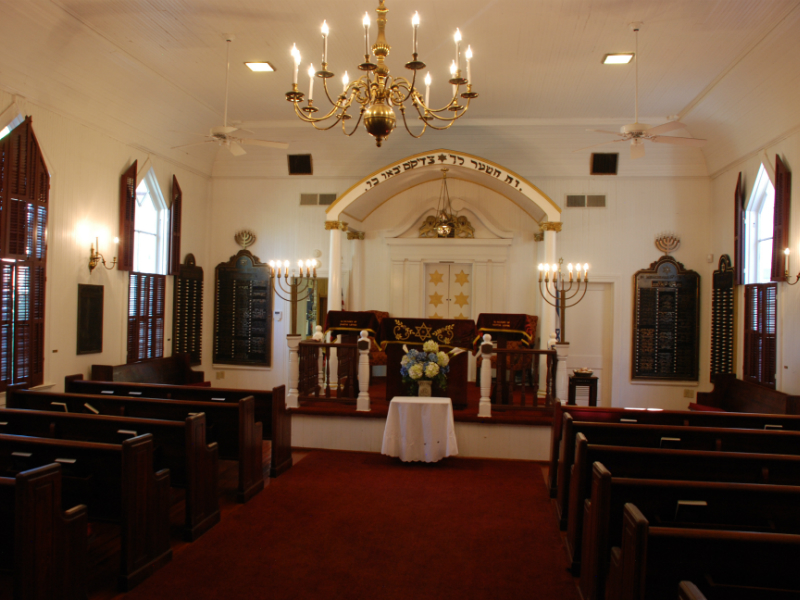Midway between Charleston, S.C., and Savannah, Ga., is the small town of Beaufort located on Port Royal Island, one of the largest sea islands on the southeastern Atlantic coast. Outdoor enthusiasts come to explore the nearby islands, while other visitors seek out the region’s rich history.
An impressive list of Antebellum-era (late 18th century to the start of the American Civil War) plantations and homes are listed on the National Register of Historic Places in South Carolina. Beaufort, in fact, is the second-oldest city in South Carolina, having been chartered in 1711. The National Trust for Historic Preservation has designated the entire downtown area as a historic district.
While driving between Hilton Head Island and Charleston, I took a detour to Beaufort, which was recently voted the south’s best small town by Southern Living magazine.
Documents show that Jews lived in Beaufort long before its first synagogue, Beth Israel, was dedicated in 1908. A sign in front of the synagogue states that “Beaufort’s Jewish community dates before the American Revolution.” Meyer Jacobs became the town’s first Jewish mayor in 1831. Lacking a Jewish cemetery in the 18th and 19th centuries, some of its early Jewish residents were buried at the Mordecai Sheftall Cemetery in Savannah, or in one of Charleston’s Jewish cemeteries.

From the latter part of the 19th century until the 1930s, Ashkenazic Jews arrived from Russia, Latvia and Lithuania, as well as from Western Europe. In many cases, these immigrants were escaping religious persecution, or were seeking economic opportunities. These Jews initially celebrated Shabbat and Jewish holidays in private homes and later at the Masonic Hall and at the Beaufort Arsenal, which was built in 1798.
In the wake of the American Civil War, most eastern European Jews migrated to large urban areas in the north. Southern towns like Beaufort were being transformed from a plantation economy to a commercial and industrial economy and tended to have fewer opportunities. The discovery of phosphate on the river bottoms ignited Beaufort’s economy and brought thousands of new jobs. This upsurge in the economy was short, as an 1893 hurricane destroyed Beaufort’s phosphate industry. Within a couple of decades, the Port Royal and Augusta railroads had gone into bankruptcy.
READ: A SYNAGOGUE AND CEMETERY HIGH ABOVE SEA LEVEL
In 1905, five members of this community applied for Beth Israel’s incorporation and petitioned for the right to purchase a lot and build a synagogue. The modest, white clapboard synagogue was built in 1908. It is unclear how this small community raised sufficient funds to purchase the land or construct a building during an economically depressed time. However, records indicate that Jews owned many retail stores at the time.
The need to bury a child led to the eventual purchase of a parcel of land for a cemetery. In the meantime, the child’s body was transported to Charleston and buried at the Magnolia Cemetery. Within a couple of years, it was no longer necessary to bury Beaufort’s Jews in another city.

Paul Keyserling met us at the synagogue. The floorboards creaked as he led us into the sanctuary lined with wooden pews and burgundy carpet. Brown wooden shutters covered the elongated pentagon windows. When we exited the building, we observed similarly shaped windows on a nearby structure. The raised bimah near the back of the room had a white ark with six gold-coloured Stars of David holding two Torahs dating to the mid-19th century. In the ’50s, a social hall was constructed and air conditioning, central heating and indoor plumbing were added to the structure. Black-and-white photos lining the walls of the social hall take visitors back to an earlier time.
Keyserling spent time reminiscing about his roots in the community and what it was like to be raised in a small southern town. “We all grew up together. I learned the service and the rabbi tutored me. Nowadays, the Jews of childbearing age have gone elsewhere to seek better economic opportunities,” he said.
He couldn’t recall when the last bar or bat mitzvah occurred. It has also been some time since the synagogue employed a rabbi. Unless there is a visiting rabbi or cantor, a member conducts services. Shabbat services are held on Friday nights, to accommodate the members.
The Jewish population reached its peak during the mass migration of Jews from eastern Europe. Some time thereafter, the membership started to decrease. In 1949, when the second generation was no longer interested in Orthodox Judaism, the leadership chose to affiliate with the United Synagogue of America. As the Conservative synagogue’s numbers continued to decline, the shul has become more flexible and will do whatever works for its shrinking membership.
Our last stop before lunch was the cemetery. Unlike other dwindling Jewish communities that struggle to maintain a cemetery, the Beth Israel cemetery, located on a heavily wooded lot, is in remarkably good condition.
Without an influx of young Jewish families to Beaufort, Beth Israel will continue to struggle. The dearth of children is a disheartening indicator of a Jewish community that lacks internal growth. Perhaps the current upswing in tourism and interest in the community will entice Jewish entrepreneurs to relocate to Beaufort.
